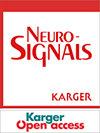新发精神病的脑弥散变化及状态依赖性精神病理的影响
Q1 Medicine
引用次数: 24
摘要
背景/目的:先前的弥散张量成像(DTI)研究已经显示了高危精神状态(ARMS)精神病患者和首发精神病(FEP)患者脑白质的微结构变化。然而,只有少数研究在临床高危样本中进行,两组的结果不一致,特别是沿上纵束(SLF)。方法:本DTI研究采用基于束的空间统计(TBSS)方法比较ARMS受试者、未治疗和抗精神病药物治疗的FEP患者和健康对照组(HC)全脑和SLF的分数各向异性(FA)和平均扩散率(MD)。结果:与HC相比,ARMS和FEP患者包括SLF在内的全脑不同区域FA增加,MD减少。SLF中的FA与ARMS和FEP个体的阳性精神病症状呈正相关。此外,未经治疗和未治疗的FEP患者显示左侧下纵束和右侧SLF的FA增加。结论:本研究揭示了包括SLF在内的广泛白质束的早期精神病FA增加和MD减少。我们的研究结果进一步表明,SLF的微观结构变化可能与状态依赖性精神病理有关。本文章由计算机程序翻译,如有差异,请以英文原文为准。
Brain Diffusion Changes in Emerging Psychosis and the Impact of State-Dependent Psychopathology
Background/Aims: Previous diffusion tensor imaging (DTI) studies have shown microstructural changes in the brain white matter of at-risk mental state (ARMS) subjects for psychosis and patients with first-episode psychosis (FEP). However, only a few studies have been conducted in clinical high-risk samples and findings in both groups are inconsistent, in particular along the superior longitudinal fasciculus (SLF). Methods: This DTI study used tract-based spatial statistics (TBSS) to compare fractional anisotropy (FA) and mean diffusivity (MD) between ARMS subjects, untreated and antipsychotic-treated FEP patients and healthy controls (HC) across the whole brain and the SLF. Results: Compared to HC, ARMS and FEP patients showed increased FA and decreased MD in diverse regions across the whole brain including the SLF. FA in the SLF was positively correlated with positive psychotic symptoms in ARMS and FEP individuals. Furthermore, untreated but not treated FEP patients showed increased FA in the left inferior longitudinal fasciculus and right SLF. Conclusion: This study revealed increased FA and decreased MD in early stages of psychosis in widespread white matter tracts including the SLF. Our findings further suggest that microstructural changes in the SLF are probably related to state-dependent psychopathology.
求助全文
通过发布文献求助,成功后即可免费获取论文全文。
去求助
来源期刊

Neurosignals
医学-神经科学
CiteScore
3.40
自引率
0.00%
发文量
3
审稿时长
>12 weeks
期刊介绍:
Neurosignals is an international journal dedicated to publishing original articles and reviews in the field of neuronal communication. Novel findings related to signaling molecules, channels and transporters, pathways and networks that are associated with development and function of the nervous system are welcome. The scope of the journal includes genetics, molecular biology, bioinformatics, (patho)physiology, (patho)biochemistry, pharmacology & toxicology, imaging and clinical neurology & psychiatry. Reported observations should significantly advance our understanding of neuronal signaling in health & disease and be presented in a format applicable to an interdisciplinary readership.
 求助内容:
求助内容: 应助结果提醒方式:
应助结果提醒方式:


